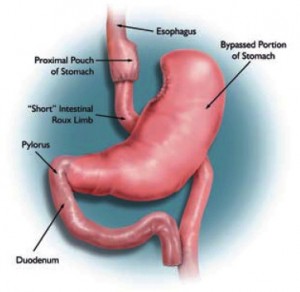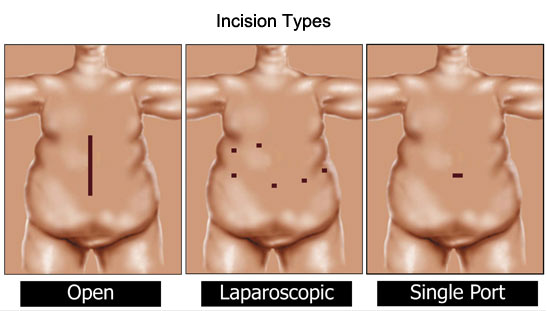Laparoscopic Gastric Bypass
The Roux-en-Y Gastric Bypass Surgical Procedure
Riverside Surgical at Sebastian River Medical Center performs the Roux-en-Y gastric bypass procedure. According to the American Society for Metabolic and Bariatric Surgery and the National Institutes of Health, Roux-en-Y gastric bypass is the current gold standard procedure for weight loss surgery. It is one of the most frequently performed weight loss procedures in the United States.
In this procedure, the surgeon uses a stapling device to create a small (30 cc) stomach pouch. The remainder of the stomach is not removed, but is completely separated from the pouch. 
The outlet from this newly formed pouch empties directly into the lower portion of the jejunum (the middle section of the small intestine), bypassing 100 to 150 cm of small intestine. This is done by dividing the small intestine just beyond the duodenum (first part of the small intestine) for the purpose of bringing it up and constructing a connection with the newly formed stomach pouch. The other end is connected into the side of the Roux limb of the intestine creating the “Y” shape that gives the technique its name. The length of either segment of the intestine can be increased to produce lower or higher levels of malabsorption.
This procedure is both restrictive and malabsorptive. In recent years, better clinical understanding of procedures combining restrictive and malabsorptive approaches has increased the choices of effective weight loss surgery for thousands of patients. By adding malabsorption, food is delayed in mixing with bile and pancreatic juices that aid in the absorption of nutrients. The result is an early sense of fullness, combined with a sense of satisfaction that reduces the desire to eat. We perform this procedure both laparosocpically or robotically assisted. Hospital stay is 2-3 days and complete recovery is 2-3 weeks.
 The average excess weight loss after the Roux-en-Y procedure is higher in patients who comply with the diet and exercise programs prescribed after surgery. One year after surgery, weight loss can average 77 percent of excess body weight (We expect our patients to lose between 50%-80% of their excess body weight).
The average excess weight loss after the Roux-en-Y procedure is higher in patients who comply with the diet and exercise programs prescribed after surgery. One year after surgery, weight loss can average 77 percent of excess body weight (We expect our patients to lose between 50%-80% of their excess body weight).
Studies show that the Roux-en-Y gastric bypass is the most durable and long lasting weight loss surgery known to date.
Studies show that most associated health conditions studied (back pain, sleep apnea, high blood pressure, high cholesterol, diabetes and depression) were improved or resolved after surgery.
Laparoscopic Roux-en-Y Gastric Bypass
In most patients, Roux-en-Y can be performed laparoscopically. When a laparoscopic operation is performed, a small video camera is inserted into the abdomen. The surgeon views the procedure on a separate video monitor. Most laparoscopic surgeons believe this gives them better visualization and access to key anatomical structures.
The camera and surgical instruments are inserted through small incisions made in the abdominal wall. This approach is less invasive because it replaces the need for one long incision to open the abdomen. Studies show that patients having had laparoscopic weight loss surgery experience less pain after surgery resulting in easier breathing and lung function and higher overall oxygen levels. Other realized benefits with laparoscopy have been fewer wound complications such as infection or hernia, and patients returning more quickly to pre-surgical levels of activity. We also perform this surgery with robotic assistance. This approach allows us to have 3D visualization and even fewer incisions than the laparoscopic approach.
because it replaces the need for one long incision to open the abdomen. Studies show that patients having had laparoscopic weight loss surgery experience less pain after surgery resulting in easier breathing and lung function and higher overall oxygen levels. Other realized benefits with laparoscopy have been fewer wound complications such as infection or hernia, and patients returning more quickly to pre-surgical levels of activity. We also perform this surgery with robotic assistance. This approach allows us to have 3D visualization and even fewer incisions than the laparoscopic approach.
Laparoscopic procedures for weight loss surgery employ the same internal technique as their “open” counterparts and produce similar excess weight loss. Not all patients are candidates for this approach and this will be addressed during their meeting with the surgeon.
